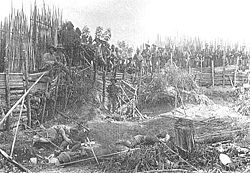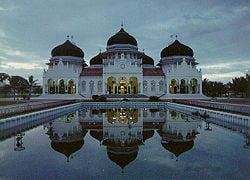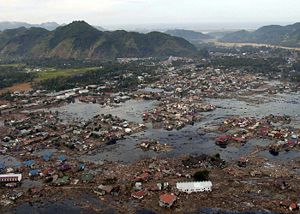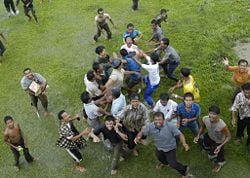Difference between revisions of "Aceh" - New World Encyclopedia
Mike Butler (talk | contribs) (Aceh - importing) |
Mike Butler (talk | contribs) m |
||
| Line 123: | Line 123: | ||
[[Category:Disputed territories]] | [[Category:Disputed territories]] | ||
[[Category:Provinces of Indonesia]] | [[Category:Provinces of Indonesia]] | ||
| + | {{credit|42893118}} | ||
Revision as of 05:35, 13 June 2006
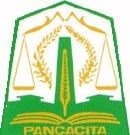
| |
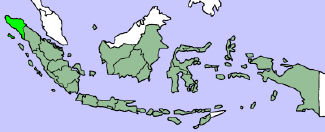 | |
| Capital | Banda Aceh |
| Governor | Dr. Ir. Mustafa Abubakar, MSi |
| Population | 4,010,860 |
| Ethnic groups | Acehnese, Gayo, Alas, Aneuk Jamee, Malay, Javanese, Kluet, Batak |
| Religion | Islam (97.6%), Christianity (1.7%), Hindu (0.08%), Buddhism (0.55%) |
| Languages | Acehnese, Indonesian |
| Time zone | WIB (UTC+7) |
| Web site | http://www.nad.go.id/ |
Aceh (IPA pronunciation: [ʔaˈtɕɛh], pronounced approximately AH-chay, but with [e], not [ei] at the end) is a special territory (daerah istimewa) of Indonesia, located on the northern tip of the island of Sumatra. Its full name is Nanggröe Aceh Darussalam. Past spellings of its name include Acheh, Atjeh and Achin.
In the past, Aceh was known for its political independence and fierce resistance to control by outsiders, including the former Dutch colonists and the Indonesian government. From 1976 until the tsunami in 2004, Aceh was torn by a separatist conflict waged by the Free Aceh Movement against the Jakarta government rooted in issues over control of resources, and over cultural and religious issues. Aceh has substantial natural resources, including oil and gas - some estimates put Aceh gas reserves as being the largest in the world. Relative to most of Indonesia, it is a religiously conservative area.
Aceh was the closest point of land to the epicenter of the massive 2004 Indian Ocean earthquake, which triggered a tsunami that devastated much of the western coast of the region, including part of the capital of Banda Aceh. From 130,000 - 238,000 persons were dead or missing, with a further 500,000 plus being made homeless. This led to a peace agreement between the government of Indonesia and GAM, mediated by former Finnish president Martti Ahtisaari, with the signing of a MoU on August 15, 2005. As of February 2006, the peace has held.
History
Islam first entered Southeast Asia through Aceh in the 8th century. The first Islamic Kingdom of Peureulak was established around 850 C.E. in what is today East Aceh district with Banda Khalifah as its capital. Then follows Samudra Pasai (from which the name Sumatara derives) in what is today North Aceh district, which was recorded by Marco Polo and Ibn Batutah during the reign of Sultan Malik uz Zahir.
The Kingdom of Aceh was established initially as a small Islamic kingdom in what is today Banda Aceh during the 12th century AD. During its golden era, its territory and political influence expanded as far as Satun in southern Thailand, Johor in Malay Peninsula, and Siak in what is today Riau province. From the beginning of the 16th century, the Sultanate of Aceh was involved in an almost continuous power struggle first with Portugal, then, from the 18th century, against British and Dutch colonial interests. At the end of the 18th century, Aceh had to give up its traditional territory of Kedah and Pinang on the Malay Peninsula to the British.
By the early nineteenth century, however, Aceh had become an increasingly influential power due to its strategic location for controlling regional trade. In the 1820s it was the producer of over half the world's supply of black pepper. The pepper trade produced new wealth for the sultanate, but also for the rulers of many smaller nearby ports that had been under Aceh's control, but were now able to assert more independence. These changes initially threatened Aceh's integrity, but a new sultan Tuanku Ibrahim, who controlled the kingdom from 1838 to 1870, aggressively, and successfully, reasserted power over nearby ports.[1]
Under the Anglo-Dutch Treaty of 1824 the British ceded their colonial possessions on Sumatra to the Dutch. In the treaty, the British described Aceh as one of their possessions, although they had no actual control over the sultanate. Initially, under the agreement the Dutch agreed to respect Aceh's independence. In 1871, however, the British dropped previous opposition to a Dutch invasion of Aceh, possibly to prevent France or the United States from gaining a foothold in the region. Although neither the Dutch nor the British knew the specifics, there had been rumors since the 1850s that Aceh had been in communication with rulers of France and of the Ottoman Empire.[1]
The Aceh War
The Dutch colonial government declared war on Aceh on 26 March 1873; the apparent immediate trigger for their invasion was discussions between representatives of Aceh and the United States in Singapore during early 1873.[1] An expedition under Major General Köhler was sent out in 1874, which was able to occupy most of the coastal areas. It was the intention of the Dutch to attack and take the Sultan's palace, which would also lead to the occupation of the entire country. The Sultan requested and possibly received military aid from Italy and the United Kingdom in Singapore: in any case the Aceh army was rapidly modernized, and Aceh soldiers managed to kill Köhler (a monument of this achievement has been built inside Grand Mosque of Banda Aceh). Köhler made some grave tactical errors and the reputation of the Dutch was severely harmed.
A second expedition led by General Van Swieten managed to capture the kraton (sultan's palace): the Sultan had however been warned, and had escaped capture. Intermittent guerrilla warfare continued in the region for ten years, with many victims on both sides. Around 1880 the Dutch strategy changed, and rather than continuing the war, they now concentrated on defending areas they already controlled, which were mostly limited to the capital city (modern Banda Aceh), and the harbour town of Ulee Lheue. On 13 October 1880 the colonial government declared the war as over, but continued spending heavily to maintain control over the areas it occupied.
War began again in 1883, when the British ship Nisero was stranded in Aceh, in an area where the Dutch had little influence. A local leader asked for ransom from both the Dutch and the British, and under British pressure the Dutch were forced to attempt to liberate the sailors. After a failed Dutch attempt to rescue the hostages, where the local leader Teuku Umar was asked for help but he refused, the Dutch together with the British invaded the territory. The Sultan gave up the hostages, and received a large amount in cash in exchange.
The Dutch Minister of Warfare Weitzel now again declared open war on Aceh, and warfare continued, with little success, as before. The Dutch now also tried to enlist local leaders: the aforementioned Umar was bought with cash, opium, and weapons. Umar received the title panglima prang besar (upper warlord of the government).
Umar called himself rather Teuku Djohan Pahlawan (Johan the heroic). On 1 January 1894 Umar even received Dutch aid to build an army. However, two years later Umar attacked the Dutch with his new army, rather than aiding the Dutch in subjugating inner Aceh. This is recorded in Dutch history as "Het verraad van Teukoe Oemar" (the treason of Teuku Umar).
In 1892 and 1893 Aceh remained independent, despite the Dutch efforts. Major J.B. van Heutsz, a colonial military leader, then wrote a series of articles on Aceh. He was supported by Dr Snouck Hurgronje of the University of Leiden, then the leading Dutch expert on Islam. Hurgronje managed to get the confidence of many Aceh leaders and gathered valuable intelligence for the Dutch government. His works remained an official secret for many years. In Hurgronje's analysis of Acehnese society, he minimised the role of the Sultan and argued that attention should be paid to the hereditary chiefs, the Ulee Balang, who he felt could be trusted as local administrators. However, he argued, Aceh's religious leaders, the ulema, could not be trusted or persuaded to cooperate, and must be destroyed.
This advice was followed: in 1898 Van Heutsz was proclaimed governor of Aceh, and with his lieutenant, later Dutch Prime Minister Hendrikus Colijn, would finally conquer most of Aceh. They followed Hurgronje's suggestions, finding cooperative uleebelang that would support them in the countryside. Van Heutsz charged Colonel Van Daalen with breaking remaining resistance. Van Daalen destroyed several villages, killing at least 2,900 Acehnese, among which were 1,150 women and children. Dutch losses numbered just 26, and Van Daalen was promoted. By 1904 most of Aceh was under Dutch control, and had an indigenous government that cooperated with the colonial state. Estimated total casualties on the Aceh side range from 50,000 to 100,000 dead, and over a million wounded.
Colonial influence in the remote highland areas was never substantial, however, and limited guerrilla resistance remained. Lead mostly by the religious ulema, intermittent fighting continued until about 1910, and parts of the province were still not pacified when the Dutch Indies became independent Indonesia following the end of the Japanese occupation of Indonesia.
Independence
During the Indonesian National Revolution after World War II, when the Dutch military attempted to regain control of its former colony, Dutch forces did not attempt to invade Aceh.[1] Upon independence, Indonesian troops were dispatched to annex the region, causing resentment over what some Acehnese viewed as foreign occupation by forces from Java. From then until the Tsunami, there were periodic armed conflicts between the Indonesian military and local forces fighing for greater separation from the central government.
In 1959 the Indonesian government yielded in part and gave Aceh a "special territory" (daerah istimewa) status, giving it a greater degree of autonomy from the central government in Jakarta than most other regions of Indonesia have. For example, the regional government is empowered to construct a legal system independent of the national government. In 2003, a form of sharia, or Islamic law, was formally introduced in Aceh. [1]
Tsunami disaster
The western coastal areas of Aceh, including the cities of Banda Aceh, Calang, and Meulaboh, were among the areas hardest-hit by the tsunami resulting from the 2004 Indian Ocean earthquake on December 26 2004. While estimates vary, approximately 230,000 people were killed by the earthquake and tsunami in Aceh, and about 400,000 were left homeless.
The population of Aceh before Dec 2004 tsunami was 4.271 million (Data from KPU (General Election Committee) in 2004). The population now is 4,031,589 (As September 15, 2005), almost two percent of the Indonesian population.
As of February 2006, more than a year after the tsunami, a large number of people are still living in barrack-style temporary living centers (TLC) or tents. Reconstruction is visible everywhere, but due to the sheer scale of the disaster, logistical issues, and the lack of funding, progress is slow.
Most Acehnese however, are very optimistic for the future. Many see the tsunami as a mixed blessing, bringing peace and an international presence to Aceh. As homes are being built and peoples' basic needs are met, the people are also looking to improve the quality of education, increase tourism, and develop responsible, sustainable industry. Well-qualified educators are in high demand in Aceh.
While parts of Banda Aceh, the capital, were unscathed, the areas closest to the water, especially in Kampung Jawa, were completely destroyed. Most of the rest of the western coast and outlying islands were severely damaged, and many towns completely disappeared. Other towns on Aceh's west coast hit by the disaster include Leupung, Lamno, Patek, Calang, Teunom, and the island of Simeulue. Affected or destroyed towns on the region's north & east coast include Pidie, Samalanga, and Lhokseumawe.
The area is slowly being rebuilt after the disaster. The government initially proposed the creation of a two-kilometer buffer zone along low-lying coastal areas, within which permanent construction is not permitted. This proposal was unpopular among some local inhabitants and proved impractical in most situations, especially fishing families that are dependent on living near to the sea.
Most of the reconstruction work is being performed by local people using a mix of traditional methods and partial prefabricated structures, with funding coming from many international organizations and individuals, governments, and the people themselves.
Secession movement
Aceh has a long history of resistance to control by outside forces; since Indonesian independence, this has meant resistance to control by the national government in Jakarta. This resistance has both economic and sociocultural roots.
Many Acehnese people feel that most of the economic benefits of the region's great natural resources, especially oil, leave the region and benefit the Jakarta government and foreign corporations instead of the local area. Aceh possesses one of Indonesia's largest reserves of oil and natural gas. A number of multinational corporations, such as Exxon Mobil, maintain a presence in Aceh.
The sociocultural divide between Aceh and the rest of Indonesia exists for several reasons. The Acehnese practice fully the teaching of Islam, while the rest of the archipelago tend to blend Islam with animism and local tradition, due to its historical trade links with the Middle East. The secular nationalism espoused by Suharto's New Order regime (1965-1998), which promoted 'Indonesian culture', was viewed by many Acehnese as merely a cover for Javanese chauvinism and a threat for their Islamic tradition.
This dissatisfaction has led to movements to push for greater autonomy or complete separation. It was out of these groups that the armed secessionists of the Free Aceh Movement (GAM) emerged. Conflict between the GAM and Indonesian forces led to the province being subject to martial law and being named a "military operational zone" by the Suharto's government.
After the Suharto regime fell in 1998, Aceh quieted down substantially leading to a 2002 Cessation of Hostilities Agreement (CoHA) between the GAM and the Indonesian military. This collapsed in May 2003, however, and the government introduced martial law and began a large-scale offensive in the region. In November 2003, martial law was extended for a further six months. According to a Human Rights Watch report [2], the Indonesian military committed widespread human rights abuses during the invasion and occupation, with more than 100,000 people being displaced in the first seven months of martial law and extra-judicial killings being common.
After the devastating tsunami in December 2004, both sides declared a cease-fire and reiterated the need to resolve the conflict. Because of the past separatist movement in the area, the Indonesian government used to have access restrictions in place on the press and aid workers. The Indonesian government has now, however, opened the region up to all tourists and other visitors able to enter other parts of Indonesia.
The administration of President Susilo Bambang Yudhoyono, inaugurated in late 2004, has also expressed a somewhat greater willingness to negotiate with rebel forces in the aftermath of the disaster. Yudhoyono has suggested the possibility of further increased autonomy for the region, and of amnesty for former rebels.
In 2005 peace talks held in Finland have resulted in a peace agreement that would end the long war in Aceh. Treaty was signed in Helsinki on August 15 2005. EU and five Southeast Asian countries will send 250 observers to ensure peace in the region. It remains to be seen if this peace treaty will be effective as fighting has continued during the peace talks, however in December 2005, the military wing of GAM was formally disbanded as a fighting force while at the same time, the final pull out of Jakarta troops took place, leaving in place in Aceh a military force composed of "organic" (i.e. indigenous Acehnese) troops.
Although Indonesian law bans solely regional parties contesting elections, even at a regional level, as part of the peace agreement, the Jakarta government has agreed to modify legislation which will allow GAM - a purely Acehnese organisation - to contest elections on a provincial level. As of February 2006, there has been a steady peace in Aceh.
Administration
Within the Republic of Indonesia, Aceh is governed not as a province but as a special territory (daerah istimewa), an administrative designation intended to give the area increased autonomy from the central government in Jakarta.
The capital and largest city in Aceh is Banda Aceh, located on the coast near the northern tip of Sumatra. Other major cities include Sabang, Lhokseumawe, and Langsa. Administratively, the province is subdivided into seventeen regencies and four municipalities.
Some local areas are pushing to create new autonomous areas, usually with the stated goal of enhancing local control over politics and development.
Ethnic and Cultural groups
Aceh is a diverse region occupied by several ethnic and language groups. The major ethnic groups are the Acehnese (who are distributed throughout Aceh), Gayo (in central and eastern part), Alas (in southeastern), Tamiang (in Aceh Tamiang), Aneuk Jamee (concentrated in southern and southwestern), and Simeulue (on Simeulue Island). There is also a significant population of Chinese, who are influential in the business and financial communities.
The Acehnese language (Basa Aceh) is widely spoken within the Acehnese population. This is a member of the Aceh-Chamic group of languages, whose other representatives are mostly found in Vietnam and Cambodia, and is also closely related to the Malay group of languages. Basa Aceh has many words borrowed from Malay and Arabic and traditionally was written using Arabic script. Basa Aceh is also used as local language in Langkat and Asahan (North Sumatra), and Kedah (Malaysia), and once dominated Pulau Pinang. Alas and Kluet are closely related languages within the Batak group. The Jamee language originated from Minang language in West Sumatra, with just a few variation and differences.
Aceh was once a meeting point for people from many nations, and among the present day Acehnese can be found some individuals with blue eyes, as well as others of Arab, Turkish and Indian descent. Before the tsunami, the region of Daya (Lamno) area used to have an unsually high number of people with fair complexions, and local traditions attributed this to Portuguese ancestry. [3]
External links
- (Indonesian) Official website
- Aceh.Net—Information about Aceh
- The Acheh Times
- GAM at globalsecurity.org
- Siegel, James T. 2000. The rope of God. Ann Arbor: University of Michigan Press. ISBN 0472086820
- A classic ethnographic and historical study of Aceh, and Islam in the region. Originally published in 1969
- Building Human Security in Indonesia—Overview of the conflict from the Program on Humanitarian Policy and Conflict Research, Harvard University, USA
- Aceh Sample Language at Language Museum
- Aceh Institute
- (Indonesian) Serambi Online
- (Indonesian) Media Center Aceh
| ||||||||||||||||||||||
Credits
New World Encyclopedia writers and editors rewrote and completed the Wikipedia article in accordance with New World Encyclopedia standards. This article abides by terms of the Creative Commons CC-by-sa 3.0 License (CC-by-sa), which may be used and disseminated with proper attribution. Credit is due under the terms of this license that can reference both the New World Encyclopedia contributors and the selfless volunteer contributors of the Wikimedia Foundation. To cite this article click here for a list of acceptable citing formats.The history of earlier contributions by wikipedians is accessible to researchers here:
The history of this article since it was imported to New World Encyclopedia:
Note: Some restrictions may apply to use of individual images which are separately licensed.
